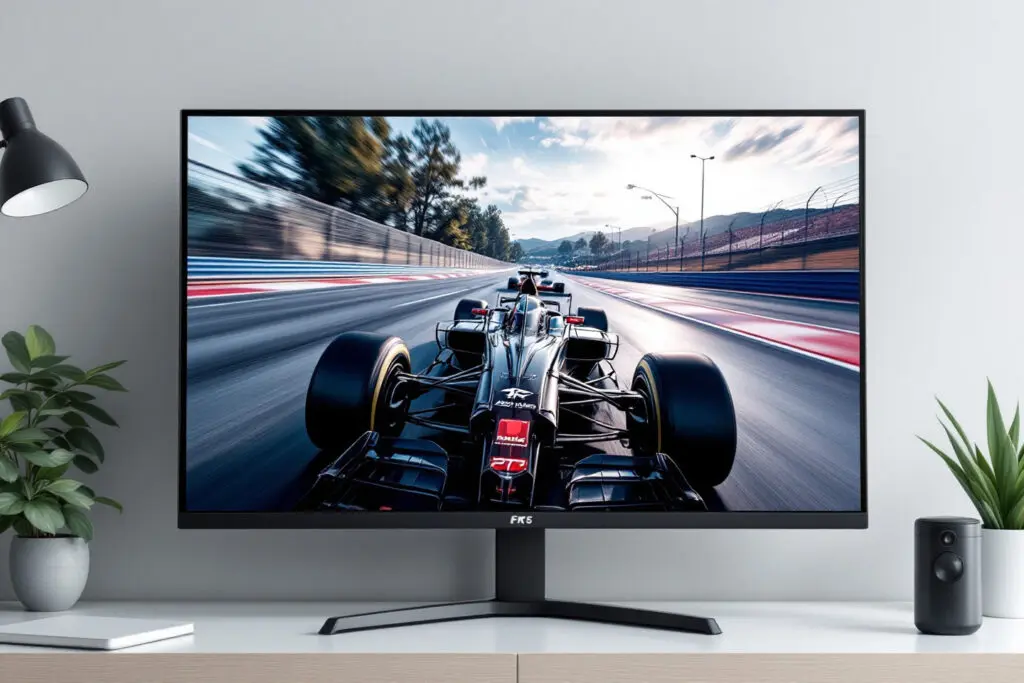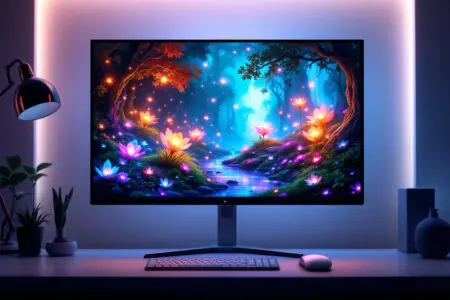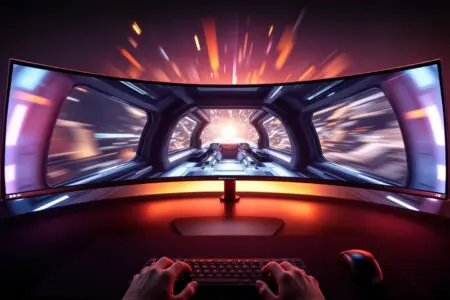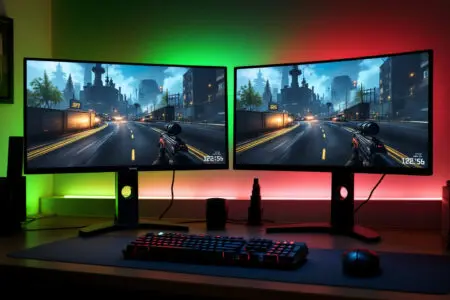I can still feel the adrenaline. My knuckles were white, my heart was hammering against my ribs, and I was leaning so far forward in my chair I was practically inside the monitor. It was the final round. A tense Valorant match. My whole team was watching. I was the last one left, and I had the last enemy right where I wanted them. I flicked my mouse. It was a perfect shot. And then my screen ripped in half.
Just for a millisecond, a disgusting horizontal line tore across my view, throwing off my aim. He got the shot. We lost. That, my friends, is screen tearing. It’s the kind of soul-crushing glitch that ruins a perfect gaming moment. If you’ve ever asked yourself what is G-Sync and why gamers won’t shut up about it, you’re in the right place. It’s the cure for the very problem that cost me that match.
This thing from Nvidia isn’t just another sticker they slap on a box. It’s a complete overhaul of the conversation between your graphics card and your monitor. It’s built from the ground up to kill screen tearing, stutter, and input lag. Put simply, it’s about making your games feel like liquid butter. No more chop. Let’s get into it.
More in Monitors Category
What is the Best Monitor Panel Type for Gaming
Key Takeaways
- The Core Function: G-Sync is an advanced display technology from Nvidia that synchronizes your monitor’s refresh rate directly to the frame rate of your Nvidia GeForce graphics card.
- The Main Benefit: Its primary purpose is to completely eliminate screen tearing and minimize stuttering and input lag, resulting in a noticeably smoother, more responsive gaming experience.
- The Requirements: To use G-Sync, you need three key components: a compatible Nvidia GeForce GPU (typically 10-series or newer), a G-Sync enabled monitor, and a DisplayPort cable connection.
- The Different Tiers: G-Sync comes in three main flavors—G-Sync Compatible, G-Sync, and G-Sync Ultimate. Each tier offers a different level of performance, features, and price, with “Compatible” being the entry-level and “Ultimate” being the premium, HDR-focused option.
So, What’s This Screen Tearing Thing Everyone Complains About?
To really get why G-Sync is a big deal, you first have to understand the enemy. Screen tearing is that hideous visual glitch I mentioned. It literally looks like someone took a picture of your game and tore it in two, with the top and bottom halves slightly misaligned. This mess happens because your graphics card (GPU) and your monitor are having a fundamental argument.
Here’s the deal. Your GPU is an overachiever, cranking out frames of your game as fast as its silicon can manage. Meanwhile, your monitor is a creature of habit. It refreshes the image on its screen at a fixed rate, measured in Hertz (Hz). A 60Hz monitor puts a new picture up 60 times a second. A 144Hz monitor does it 144 times a second. You get the idea.
The fight starts when your GPU shoves a new frame at the monitor while it’s in the middle of redrawing the screen. The monitor panics. It tries to display the new frame right away, resulting in you seeing part of the old frame and part of the new one simultaneously. That visible seam between them is the tear. It’s most obvious when you’re whipping around in a first-person shooter or a racing game—basically, anytime the action gets fast and furious.
How Did We Try to Fix This Before G-Sync?
For a long time, the only tool we had to fight screen tearing was a feature called V-Sync (Vertical Sync). V-Sync was a hammer. A clumsy one. It worked by telling the graphics card to slow down and wait its turn. Instead of firing off frames whenever they were done, the GPU had to hold onto a finished frame until the monitor was ready for it. This essentially locked your game’s frame rate to your monitor’s refresh rate. So, if you had a 60Hz monitor, your game was stuck at 60 frames per second (FPS), period.
And hey, it worked. V-Sync got rid of screen tearing by making sure the monitor only ever received complete frames. But solving one problem created two new ones that were arguably worse: stutter and input lag. It was like patching a hole in a dam with duct tape.
But V-Sync Isn’t Perfect, Right?
Not even close. The biggest knock against V-Sync is input lag. Because your GPU is sitting on a finished frame, waiting for the green light from the monitor, a delay is created. You move your mouse, but the action on screen happens a fraction of a second later. This makes your controls feel heavy, sluggish, almost like you’re playing through mud. In a competitive shooter, this “floaty” feeling is a death sentence.
Then there’s the stuttering. This rears its ugly head when your GPU hits a tough spot and can’t keep its frame rate locked to the monitor’s refresh rate. Imagine you’re on a 60Hz monitor, happily playing at 60 FPS. A huge explosion happens and your frame rate dips to 55 FPS. V-Sync’s solution is brutal. To stay in sync, it chops your frame rate in half, down to 30 FPS. That jarring leap from 60 to 30 is a massive, noticeable stutter that completely breaks your immersion.
What is G-Sync, and How Does It Actually Work Its Magic?
This is where Nvidia decided to flip the whole script. Instead of crippling the GPU to match the monitor, G-Sync makes the monitor adapt to the GPU. This is the magic of a Variable Refresh Rate (VRR). A G-Sync monitor ditches its fixed schedule. It no longer refreshes 60 or 144 times a second. Instead, it refreshes exactly when the GPU tells it to, matching its refresh rate to the GPU’s frame rate in real-time.
If your graphics card is pumping out 87 FPS in a chaotic firefight, your G-Sync monitor refreshes at exactly 87Hz. When things quiet down and the frame rate climbs to 132 FPS, the monitor follows suit, instantly refreshing at 132Hz. This is done with a special hardware chip inside dedicated G-Sync monitors or with special driver-level tuning for G-Sync Compatible displays.
The end game is a perfect partnership between what’s rendered and what’s displayed.
- Tearing is Dead: The monitor only draws a new picture when it has a full one to show. Screen tearing becomes physically impossible.
- Lag is Minimized: The GPU sends the frame the second it’s ready. This slashes the delay V-Sync created, making everything feel incredibly responsive.
- Stutter is Gone: If your frame rate dips from 90 to 80 FPS, you just see a smooth 80 FPS. There’s no catastrophic drop, so performance fluctuations are smoothed out.
It makes for a visual experience so fluid that once you’ve seen it, playing without it feels broken.
G-Sync, G-Sync Compatible, G-Sync Ultimate… What’s the Difference?
When you start shopping for a gaming monitor, you’ll see the G-Sync name has a few variations. Nvidia set up a tier system to manage expectations and price points. Knowing what each one means is key to not overspending or getting less than you hoped for.
Let’s Start with G-Sync Compatible
This is your entry ticket. A “G-Sync Compatible” monitor is actually a good quality FreeSync monitor (which uses an open VRR standard) that Nvidia has personally put through the wringer. They test these displays to make sure they provide a solid VRR experience without flickering or other weird issues. If it passes their certification, they enable G-Sync support for it in their drivers. This is the best way to get great VRR on a budget. The only potential catch is that the effective VRR range might be a bit narrower than a “true” G-Sync model.
What Makes a Monitor ‘True’ G-Sync?
This is the real deal. These monitors have a physical hardware module, a custom scaler chip made by Nvidia, installed inside. This chip gives Nvidia total control over the monitor’s performance. They run these displays through more than 300 image quality tests to guarantee excellence. The big advantage here is a VRR range that often goes from 1Hz all the way to the monitor’s max refresh rate, so it works flawlessly even at low FPS. This chip also enables Variable Overdrive, which helps eliminate motion blur for crystal-clear visuals in fast-moving games. It’s a noticeable step up in motion clarity.
Is G-Sync Ultimate Really the ‘Ultimate’ Choice?
This is the top shelf, money-is-no-object option. A G-Sync Ultimate monitor has the dedicated hardware module and all its benefits, but it also adds a certification for phenomenal HDR (High Dynamic Range). To get the Ultimate stamp, a monitor needs to hit a searing peak brightness of at least 1000 nits and use advanced backlighting.
This is for people who want the smoothest performance and the most stunning, true-to-life picture quality. My first time playing Cyberpunk 2077 in full ray-traced glory on an Ultimate display was something else. The neon lights of Night City didn’t just glow; they burned with an intensity that felt real. And all of it was delivered with that perfect G-Sync smoothness. It’s the best of all worlds.
Do I Really Need G-Sync for My Gaming Setup?
So, is this a must-have, or just a fancy extra? Honestly, it comes down to you. It depends on the games you play and how much visual hiccups bother you.
If you’re a competitive player in games like Counter-Strike 2 or Apex Legends, the answer is a resounding yes. The lower input lag gives you a more direct, one-to-one feeling with your aim. The perfect motion clarity helps you track targets better. When a single millisecond is the difference between winning and losing, G-Sync is a real advantage.
If you’re someone who loves to get lost in huge, cinematic single-player games like Red Dead Redemption 2 or Baldur’s Gate 3, G-Sync’s job is to protect your immersion. Tearing and stuttering are glitches that remind you you’re playing a game. G-Sync erases them, helping you stay completely absorbed in the world and the story. It just makes everything feel more solid.
What if I Have a Super Powerful Graphics Card?
Some people think a monster GPU like an RTX 4090 makes G-Sync irrelevant. That’s not quite right. While a beastly card can push insane frame rates, it can’t maintain a perfectly flat line. No card can. There will always be fluctuations when a huge explosion goes off or you enter a dense, new area. A drop from 160 FPS to 120 FPS is still a big swing. Without G-Sync, you’ll feel that as a micro-stutter. G-Sync is the suspension that smooths out those bumps in the road, ensuring a perfectly fluid ride no matter what.
What Do I Need to Get G-Sync Running?
Getting G-Sync up and running is incredibly easy. You just need to have the right gear and tick a box in the settings. That’s it. Here’s your checklist:
- A Compatible Nvidia GPU: You’ll need a GeForce graphics card, anything from the 10-series (like a GTX 1070) or newer will do. That includes all RTX 20, 30, and 40-series cards.
- A G-Sync Monitor: You need a display that’s officially certified as G-Sync, G-Sync Compatible, or G-Sync Ultimate. Look for the logo.
- The Right Cable: This is critical. You must use a DisplayPort cable to connect your GPU to your monitor. It’s the standard that guarantees G-Sync will work as intended.
- The Nvidia Driver Settings: With everything plugged in, just right-click your desktop, open the Nvidia Control Panel, find the “Set up G-SYNC” tab, and make sure the box is checked. You’re done.
Is G-Sync Worth the Extra Cost?
There’s no sugarcoating it: G-Sync monitors, especially the ones with the dedicated hardware, cost more than their counterparts. This “G-Sync tax” is real. So, should you pay it?
I think of it as an investment in the quality of your gaming time. You spend good money on a fast GPU to produce high frame rates. You buy a fast CPU to run the game’s logic. G-Sync is the part that ensures all that power is delivered to your eyes perfectly. It makes sure the hard work your other components are doing isn’t ruined at the last second by a clumsy handoff to the display.
If you’ve already invested in a powerful gaming rig, spending a bit more on a G-Sync monitor is what completes the build. It elevates the entire experience. For a deeper dive into the science, you can find papers on display rendering from places like Stanford University’s graphics courses that cover these fundamentals.
The Final Frame: A Smoother Reality
In PC gaming, we’re always chasing more. More frames. More graphical fidelity. G-Sync is a reminder that how those frames are delivered is just as important as how many there are. It’s about the feel of the game.
It’s the technology that gets out of the way, removing the technical annoyances that pull you out of the experience. It allows for deeper immersion and requires less of your brain to compensate for visual noise, freeing you up to focus on the game itself. And I can tell you from years of experience, once you get used to that perfect, liquid-smooth gameplay, there is absolutely no going back.
FAQ – What is G-Sync
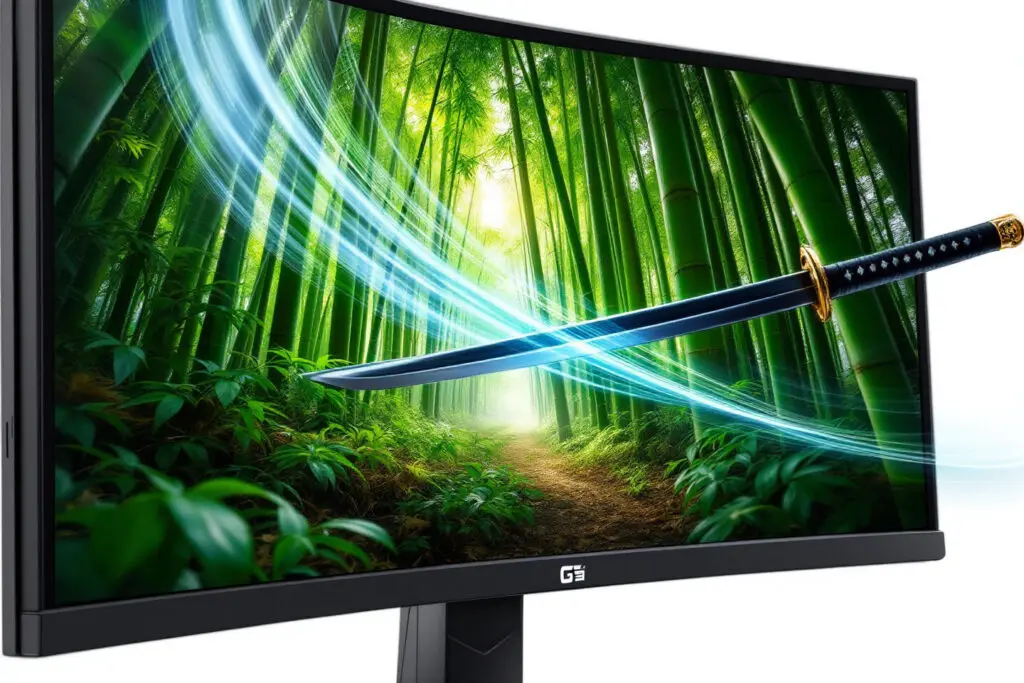
Is investing in G-Sync necessary for all gamers and why?
Not all gamers need G-Sync, but for competitive players and those wanting the best visual immersion, it significantly improves gameplay by providing smoother visuals and more precise control, especially when frame rates fluctuate or during fast-paced action.
How does G-Sync technically work to prevent screen tearing?
G-Sync uses a Variable Refresh Rate (VRR) technology where the monitor dynamically adjusts its refresh rate to match the GPU’s frame rate, ensuring that the display only updates when a full frame is ready, preventing tear and reducing lag.
Why was V-Sync considered an imperfect solution for screen tearing?
V-Sync worked by locking the frame rate to the monitor’s refresh rate, which reduced tearing but caused additional problems like input lag and stuttering during frame rate dips, making gameplay feel sluggish and less smooth.

